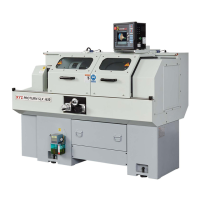Note: To avoid pulling the wires out of the connector, use the loop to pull the connector from
the Servo Driver.
If the problem moves to the other axis and clears up from the original axis, replace
the Servo Driver.
4.6 Electrical
4.6.1 Checking A/C Voltage
This procedure tests for the 115V power for the control.
Use a Voltmeter, reading A/C volts
Acceptable range is 110V to 130V
Note: systems running consistently close to the high or low values may have problems when
normal voltage fluctuations push the voltage out of the acceptable range.
The system is shipped out assuming the customers shop has 415 V power. If the
transformer secondary tap is set on 115 volts. Measure the voltage coming out of the
transformer by placing the voltmeter across the 115 V and 0 V taps. If this measurement is
above 120 volts then move the tap from 115 V to 110 V. If the reading is low, 110 V or
below, then change the tap from 115 V to 124 V. Input power to the machine that is 430 V
or above will cause the 110 voltage to be high and voltage that is 405 V or below typically
causes 110 voltage to be low.
4.6.2 Checking Fuses
There are 11 fuses that make up the system on the 1630. There are 2 fuses in the
pendant, 3 fuses on the spindle control module and 6 fuses on the power module.
To check fuses:
1. Use a Volt/Ohmmeter; select “OHM” or “”.
2. Remove the fuse completely from the pendant display or electrical box.
3. Place a lead of the meter on each end of the fuse.
A good fuse reads 0 (zero) or close to it.
A bad fuse reads Open or Infinity or OL (overload).

